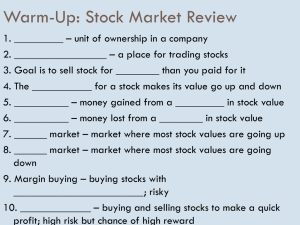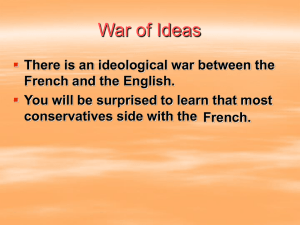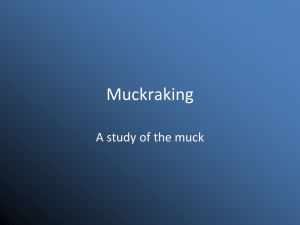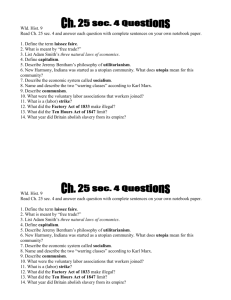1. Triumph of Urban Capitalism:1876
advertisement
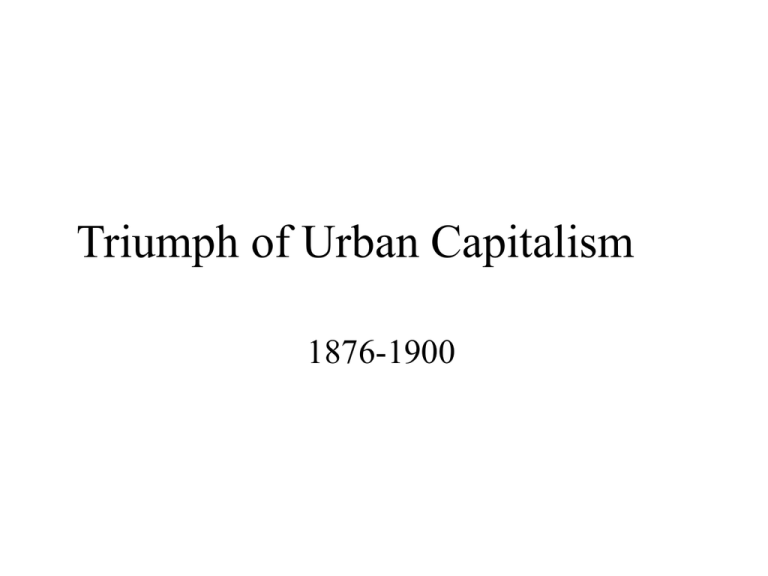
Triumph of Urban Capitalism 1876-1900 What is urban capitalism? What is economic growth? • Economic growth: Economic development involves both quantitative and, above all, ___________________ change. • Examples of economic growth, now & then • Manufacturing Output. Compared with 1900, manufacturing output in the United States in 1870 was _______ percent. Four Sources of Economic Growth • • • • Westward Movement. Six New Industries Rise of Big Business Public mood favorable to economic growth Westward Movement • __________________ of large numbers of people coupled with the introduction of _______________ into the American _____ ____________________. • Film: The Real West Six New Industries • Telephone: What effect did the coming of the telephone have on business? • Electrical Power – Three-fold role of Thomas Alva Edison • Steel – How did this industry resolve a technological bottleneck? – Andrew Carnegie Six New Industries (Continued) • Petroleum Industry: In the late 19th century what products were output from the petroleum industry? • Railroad Industry: What impact did the growth of the railroad network have on the American economy by 1900? • Food Processing: What did Gustav Swift and Philip Armour invent? Rise of Big Business • What are other ways of asking this question? • What institution emerges as a major force in American business and the American economy during this period? Rise of Big Business (cont.) 1. Before the Civil War, how were most businesses in the United States organized? 2. Post-Civil War business opportunities as a result of railroad growth leading to larger markets-nationalization of the economy 3. How can a business owner exploit the new opportunities? Rise of Big Business (cont.) 4. Expanding output by means of: • • Mechanization Factory System 5. Financial Bottleneck • • Mechanization requires massive amounts of financial capital Business Law: What are the legal limits on partnerships? Rise of Big Business (cont.) – Corporations: What in business law makes the corporation attractive?: Stocks and Bonds – Corporations: What makes a corporation a good tool for governing (or managing) a large, complex organization – In which industry, even before the Civil War, did corporations make their first appearance? Rise of Big Business (cont.) 6. Boom-Bust Cycle • • • Means ___________ competition Emphasis on controlling costs “Dog eat dog” business environment 7. Consolidation as the answer—Use John D. Rockefeller & Standard Oil as example • Bring entire industries under centralized control Rise of Big Business (conclusion) – – Horizontal and vertical expansion Pools, Trusts, and Holding companies control, reduce, and eliminate competition 8. Social Result of the rise of the corporation is a new class of business managers • • Source of power of this new class Ownership and management became separate Public Mood Favorable to Economic Growth • An age of “laissez faire” attitudes toward economic activity. How the term “laissez faire” can imply different things. – Definition of laissez faire in the context of the late 19th century endorses a limited role for government – This limited role is to assist the business community to develop the economy. It rejects an “activist” concept, that is government has a legitimate role to deal with the ______________________ of economic growth Protective Tariff as an example of laissez faire • What is “the protective tariff”? • How does it work in practice? • Which group in the economy actually “pays” this tax? • Why is this tax good for all groups in society, according to its supporters? Legitimatizing Laissez Faire • Social Darwinism. Why is “dog eat dogism” good in the long run? • Gospel of Wealth – What did Andrew Carnegie say? – Who was Horatio Alger and what did he say about the principles that lead to success? Rise of the City City 1850 1900 New York City 695,115 3,437,202 Chicago 29,963 1,698,575 Boston 136,881 560,892 St. Louis 77,860 575,238 New Orleans 116,375 287,104 Omaha 102,555 Denver 133,859 San Francisco 34,776 342,782 Los Angeles 1,610 102,479 Rise of the City (Cont.) • • • • Big City -- Urban Town -- Urban Village -- Rural Countryside – Rural In what context did a majority of Americans live in 1876? In 1900? In 2000? Rise of the City (Concl.) • Rise of Big Business • Immigration: See Film, The Island Called Ellis Tensions and Conflicts • Robert Kelley-Many Americans did NOT believe that they were living in a period of prosperity, but an era of hard times. • Last few decades witnessed class conflict, social tensions, and a rural revolt against growing urban power. Class Conflict between capital and labor • Worsening of Work rather than Marxist theory helps explain • Capital demonstrated its power over labor in the: – Haymarket Riot (1886) – Homestead Strike (1892) – Pullman Strike (1894) • Examples of labor attempting to organize – Knights of Labor, Socialist parties – American Federation of Labor: Samuel Gompers & Business (or Trade) Unionism Social Tension 1. Anti-Black racism: Interests of African Americans sacrificed for national unity 2. Victorian Code: What functional roles did the husband, wife, and child have in middle class urban households. 3. Nativism: Resistance to late 19th century patterns of immigration Rural Revolt against growing urban power • Decline of the farmer as the country became more industrial – Growing economic inequality – Cultural denigration – Physical, social, and psychological isolation Rural Protest • Alliance Movement: Emphasis on economic cooperation • Populist Party: 1892 Convention – challenged laissez faire approach to the economy and government 1896 Presidential Election • Democratic party – In this campaign, the party backed monetization of silver & nominated William Jennings Bryan • Republicans stood fast on the gold standard and nominated William McKinley, an advocate of the tariff • Republicans won. Jobs were BIG issue • Bryan’s campaign pointed toward activist government. Why was this significant? A Turn in United States Foreign Policy Spanish American War—New U.S. role as great world power. Why this turning? 1. Growing dependence of the United States on world markets. 2. A new consciousness of militant nationalism. “A new consciousness seems to have come upon us…. The taste of empire is in the mouth of the people even as the taste of blood in the jungle.It means an imperial policy, the Republic taking her place with the armed nations of the world.” April 1898 A Turn in United States Foreign Policy (Cont.) 3. New definition of national security policy emphasizing “sea power”. Alfred Thayer Mahan outlined the new policy in: The Influence of Sea Power Upon History 4. 5. Venezuelan Crisis of 1895 United States initiated a new relationship with Great Britain Influence of Christianity: Protestant leaders viewed new global role for U.S. as an adjunct to expansion of Christianity
